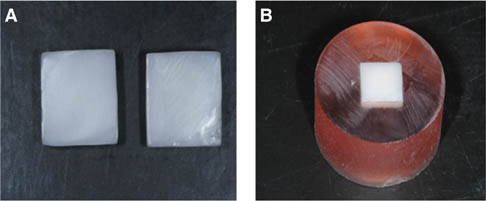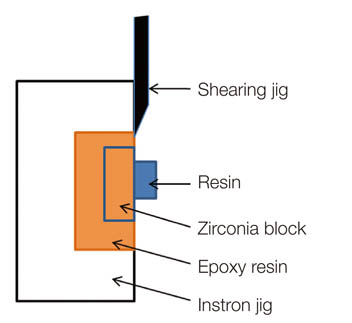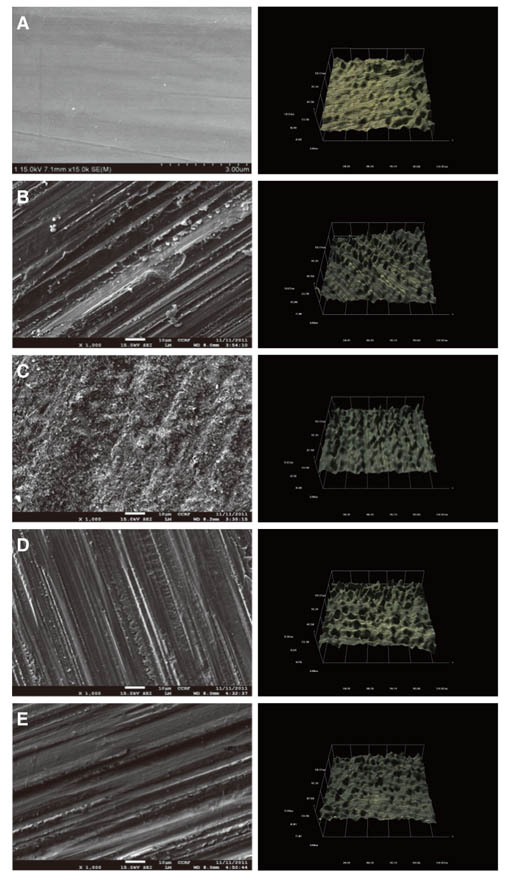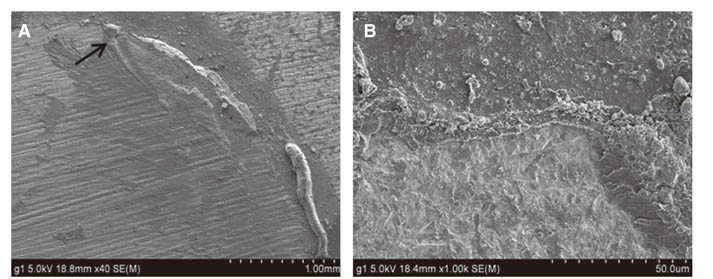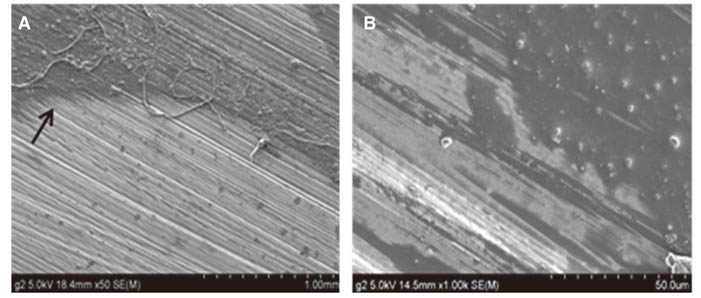J Adv Prosthodont.
2013 Aug;5(3):248-255. 10.4047/jap.2013.5.3.248.
Effect of various intraoral repair systems on the shear bond strength of composite resin to zirconia
- Affiliations
-
- 1Department of Prosthodontics, School of Dentistry, Chosun University, Republic of Korea. son0513@chosun.ac.kr
- 2Department of Dental Materials, School of Dentistry, Chosun University, Republic of Korea.
- KMID: 2118163
- DOI: http://doi.org/10.4047/jap.2013.5.3.248
Abstract
- PURPOSE
This study compared the effect of three intraoral repair systems on the bond strength between composite resin and zirconia core.
MATERIALS AND METHODS
Thirty zirconia specimens were divided into three groups according to the repair method: Group I- CoJet(TM) Repair System (3M ESPE) [chairside silica coating with 30 microm SiO2 + silanization + adhesive]; Group II- Ceramic Repair System (Ivoclar Vivadent) [etching with 37% phosphoric acid + Zirconia primer + adhesive]; Group III- Signum Zirconia Bond (Heraus) [Signum Zirconia Bond I + Signum Zirconia Bond II]. Composite resin was polymerized on each conditioned specimen. The shear bond strength was tested using a universal testing machine, and fracture sites were examined with FE-SEM. Surface morphology and wettability after surface treatments were examined additionally. The data of bond strengths were statistically analyzed with one-way ANOVA and Tamhane post hoc test (alpha=.05).
RESULTS
Increased surface roughness and the highest wettability value were observed in the CoJet sand treated specimens. The specimens treated with 37% phosphoric acid and Signum Zirconia Bond I did not show any improvement of surface irregularity, and the lowest wettability value were found in 37% phosphoric acid treated specimens. There was no significant difference in the bond strengths between Group I (7.80 +/- 0.76 MPa) and III (8.98 +/- 1.39 MPa). Group II (3.21 +/- 0.78 MPa) showed a significant difference from other groups (P<.05).
CONCLUSION
The use of Intraoral silica coating system and the application of Signum Zirconia Bond are effective for increasing the bond strength of composite resin to zirconia.
MeSH Terms
Figure
Reference
-
1. Choi BK, Han JS, Yang JH, Lee JB, Kim SH. Shear bond strength of veneering porcelain to zirconia and metal cores. J Adv Prosthodont. 2009; 1:129–135.2. Jang GW, Kim HS, Choe HC, Son MK. Fracture strength and mechanism of dental ceramic crown with zirconia thickness. Procedia Eng. 2011; 10:1556–1560.3. Ural C, Külünk T, Külünk S, Kurt M, Baba S. Determination of resin bond strength to zirconia ceramic surface using different primers. Acta Odontol Scand. 2011; 69:48–53.4. Chaiyabutr Y, McGowan S, Phillips KM, Kois JC, Giordano RA. The effect of hydrofluoric acid surface treatment and bond strength of a zirconia veneering ceramic. J Prosthet Dent. 2008; 100:194–202.5. Thompson JY, Stoner BR, Piascik JR, Smith R. Adhesion/cementation to zirconia and other non-silicate ceramics: where are we now? Dent Mater. 2011; 27:71–82.6. Triwatana P, Nagaviroj N, Tulapornchai C. Clinical performance and failures of zirconia-based fixed partial dentures: a review literature. J Adv Prosthodont. 2012; 4:76–83.7. Ural Ç, Külünk T, Külünk Ş, Kurt M. The effect of laser treatment on bonding between zirconia ceramic surface and resin cement. Acta Odontol Scand. 2010; 68:354–359.8. Kim BK, Bae HE, Shim JS, Lee KW. The influence of ceramic surface treatments on the tensile bond strength of composite resin to all-ceramic coping materials. J Prosthet Dent. 2005; 94:357–362.9. Cho HY, Won HY, Choe HC, Son MK. Fracture characteristics of dental ceramic crown according to zirconia coping design. Procedia Eng. 2011; 10:1561–1566.10. Hatta M, Shinya A, Yokoyama D, Gomi H, Vallittu PK, Shinya A. The effect of surface treatment on bond strength of layering porcelain and hybrid composite bonded to zirconium dioxide ceramics. J Prosthodont Res. 2011; 55:146–153.11. Choi YS, Kim SH, Lee JB, Han JS, Yeo IS. In vitro evaluation of fracture strength of zirconia restoration veneered with various ceramic materials. J Adv Prosthodont. 2012; 4:162–169.12. Casucci A, Monticelli F, Goracci C, Mazzitelli C, Cantoro A, Papacchini F, Ferrari M. Effect of surface pre-treatments on the zirconia ceramic-resin cement microtensile bond strength. Dent Mater. 2011; 27:1024–1030.13. Aboushelib MN, Kleverlaan CJ, Feilzer AJ. Selective infiltration-etching technique for a strong and durable bond of resin cements to zirconia-based materials. J Prosthet Dent. 2007; 98:379–388.14. Sailer I, Fehér A, Filser F, Lüthy H, Gauckler LJ, Schärer P, Franz Hämmerle CH. Prospective clinical study of zirconia posterior fixed partial dentures: 3-year follow-up. Quintessence Int. 2006; 37:685–693.15. Sailer I, Fehér A, Filser F, Gauckler LJ, Lüthy H, Hämmerle CH. Five-year clinical results of zirconia frameworks for posterior fixed partial dentures. Int J Prosthodont. 2007; 20:383–388.16. Wataha JC. Alloys for prosthodontic restorations. J Prosthet Dent. 2002; 87:351–363.17. Fischer J, Baltzer N, Fleetwood PW. Thermal creep analysis of noble metal alloys for the ceramic-fused-to-metal technique. J Biomed Mater Res. 1999; 48:258–264.18. Anusavice KJ, Carroll JE. Effect of incompatibility stress on the fit of metal-ceramic crowns. J Dent Res. 1987; 66:1341–1345.19. Della Bona A, Borba M, Benetti P, Cecchetti D. Effect of surface treatments on the bond strength of a zirconia-reinforced ceramic to composite resin. Braz Oral Res. 2007; 21:10–15.20. Park JS, Kim HS, Kim HSL, Song MK, Choe HC. Interfacial Bonding and Fracture Phenomena between Porcelain and Metal Coping. Procedia Eng. 2011; 10:1567–1572.21. Son MK, Choe HC. Evaluation of Interfacial Bonding Strength between Laser Textured Metal Coping and Porcelain. Procedia Eng. 2011; 10:2268–2291.22. Qeblawi DM, Muñoz CA, Brewer JD, Monaco EA Jr. The effect of zirconia surface treatment on flexural strength and shear bond strength to a resin cement. J Prosthet Dent. 2010; 103:210–220.23. Yang B, Wolfart S, Scharnberg M, Ludwig K, Adelung R, Kern M. Influence of contamination on zirconia ceramic bonding. J Dent Res. 2007; 86:749–753.24. Zhang Y, Lawn BR, Malament KA, Van Thompson P, Rekow ED. Damage accumulation and fatigue life of particle-abraded ceramics. Int J Prosthodont. 2006; 19:442–448.25. Zhang Y, Lawn BR, Rekow ED, Thompson VP. Effect of sandblasting on the long-term performance of dental ceramics. J Biomed Mater Res B Appl Biomater. 2004; 71:381–386.26. Gökçe B, Ozpinar B, Dündar M, Cömlekoglu E, Sen BH, Güngör MA. Bond strengths of all-ceramics: acid vs laser etching. Oper Dent. 2007; 32:173–178.27. Fischer J, Grohmann P, Stawarczyk B. Effect of zirconia surface treatments on the shear strength of zirconia/veneering ceramic composites. Dent Mater J. 2008; 27:448–454.28. Matinlinna JP, Lassila LV, Vallittu PK. The effect of a novel silane blend system on resin bond strength to silica-coated Ti substrate. J Dent. 2006; 34:436–443.29. Blatz MB, Sadan A, Martin J, Lang B. In vitro evaluation of shear bond strengths of resin to densely-sintered high-purity zirconium-oxide ceramic after long-term storage and thermal cycling. J Prosthet Dent. 2004; 91:356–362.30. Wegner SM, Kern M. Long-term resin bond strength to zirconia ceramic. J Adhes Dent. 2000; 2:139–147.31. Ersu B, Yuzugullu B, Ruya Yazici A, Canay S. Surface roughness and bond strengths of glass-infiltrated alumina-ceramics prepared using various surface treatments. J Dent. 2009; 37:848–856.32. Valandro LF, Ozcan M, Amaral R, Vanderlei A, Bottino MA. Effect of testing methods on the bond strength of resin to zirconia-alumina ceramic: microtensile versus shear test. Dent Mater J. 2008; 27:849–855.33. Chadwick RG, Mason AG, Sharp W. Attempted evaluation of three porcelain repair systems-what are we really testing? J Oral Rehabil. 1998; 25:610–615.34. Lindgren J, Smeds J, Sjögren G. Effect of surface treatments and aging in water on bond strength to zirconia. Oper Dent. 2008; 33:675–681.
- Full Text Links
- Actions
-
Cited
- CITED
-
- Close
- Share
- Similar articles
-
- Evaluation of shear bond strengths of gingiva-colored composite resin to porcelain, metal and zirconia substrates
- Effect of delayed time, surface treatment, and repair material on shear bond strength of repaired bis-acryl composite resin
- Repair bond strength of resin composite to three aged CAD/CAM blocks using different repair systems
- The effect of different bonding systems on shear bond strength of repaired composite resin
- Effect of thermocycling on shear bond strength and mode of failure of bonded retainer using flowable composite resin

